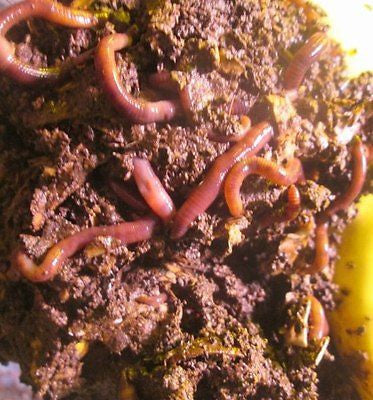Red Wigglers: Your Eco-Friendly Service for a Greener Yard
Red wigglers, or Eisenia fetida, present a lasting approach to improving yard health through vermicomposting. These worms not only promote the breakdown of natural waste however additionally add to boosted soil framework and fertility. By integrating red wigglers into your gardening practices, you can properly manage waste while nurturing a lively community (red worms). Nevertheless, the advantages prolong past simple composting; understanding the subtleties of their treatment and optimal usage can dramatically elevate your gardening efforts. What essential methods can guarantee your vermicomposting system prospers while maximizing its effect on your yard's vigor?
(Where To Buy Worms In North Carolina)
What Are Red Wigglers?
Although frequently mistaken for normal earthworms, red wigglers (Eisenia fetida) are a distinctive species understood for their efficiency in composting natural matter. These worms prosper in abundant, organic environments, such as compost heap and vermicomposting systems, where they play a vital function in damaging down waste. Unlike their even more common equivalents, red wigglers choose a warmer habitat, generally in between 55 ° F and 77 ° F, which optimizes their activity and performance.
Red wigglers are characterized by their reddish-brown coloration and segmented bodies, which can expand up to four inches in length. They have an unique capacity to eat and absorb organic products at an outstanding price, processing approximately half their body weight daily. This quick disintegration process not only enhances the dirt but additionally adds to the overall wellness of the yard ecological community.
In regards to reproduction, red wigglers are prolific, capable of generating cocoons that include several eggs. This enables quick populace growth, making them an optimal choice for composting endeavors. Their versatility and voracious cravings for organic waste position red wigglers as a vital ally for environmentally aware gardeners looking for lasting practices.
Advantages of Using Red Wigglers
Using red wigglers in the garden supplies many advantages that enhance both soil quality and plant wellness. These earthworms are exceptional decomposers, damaging down raw material such as kitchen area scraps and yard waste right into nutrient-rich castings. These spreadings, usually described as "worm gold," give crucial nutrients that enhance soil fertility, promoting lively plant growth.
Red wigglers also enhance dirt framework. Their burrowing task aerates the soil, promoting far better water infiltration and origin infiltration. This leads to a much healthier origin system, which is important for nutrient uptake and general plant vigor. Additionally, the visibility of red wigglers enhances microbial task in the dirt, producing a prospering community that adds to disease resistance and improved plant health and wellness.
An additional considerable advantage of making use of red wigglers is their capacity to reduce waste. By composting organic products via vermicomposting, gardeners can divert waste from land fills while at the same time enhancing their soil. This eco-friendly method not only supports sustainable methods however likewise promotes a much healthier atmosphere. In recap, integrating red wigglers into horticulture practices yields significant advantages, making them an important addition to any type of eco-conscious yard.
(Worm Farms Near Me)
Just How to Begin Vermicomposting
To begin vermicomposting, it's important to develop an ideal environment for red wigglers to thrive, as their success directly affects the performance of the composting process. Begin by selecting a container, such as a plastic or wooden container, with appropriate drainage and ventilation. A dimension of approximately 2 square feet is suitable for a family, permitting a manageable worm population.
Next, prepare bed linen material that is moist yet not excessively wet. Shredded paper, cardboard, and coconut coir are outstanding selections, offering a comfortable environment while additionally serving as a carbon source. Fill the container with 4 to 6 inches of bedding.
After developing the bed linens, introduce your red wigglers. A normal starting population is about 1 extra pound of worms, which can consume approximately half a pound of food scraps daily. It is essential to include food scraps gradually, focusing on vegetable peelings, fruit waste, and coffee premises, while preventing meat, milk, and oily foods to avoid smells.
Maintaining a Healthy Worm Bin
Once your red wigglers are cleared up right into their new bed linen, maintaining a healthy worm bin ends up being extremely important to make sure optimal composting conditions. Ideally, the worm container need to be maintained moist however not soggy; a moisture degree around 60-70% is optimum.
Temperature level control is similarly crucial. Red wigglers grow in atmospheres in between 55 ° F and 77 ° F(13 ° C to 25 ° C) Prevent exposing the bin to extreme temperatures; extreme heat can eliminate the worms, while too much cold can reduce their task.
Aeration is essential to avoid anaerobic problems, which can bring about unpleasant smells and damage the worms. Transform the bed linen gently every couple of weeks to promote air flow and distribute food uniformly.
Feeding your red wigglers is one more critical element. Deal a well balanced diet plan of cooking area scraps, staying clear of citrus and spicy foods, which can be damaging to their health. By frequently monitoring these variables, you can make sure a thriving environment within your worm bin.

Tips for Utilizing Worm Castings
On a regular basis integrating worm spreadings into your yard can significantly enhance soil wellness and plant growth. To properly utilize worm spreadings, start by figuring out the suitable application price, which commonly ranges from 10-20% of the total soil quantity. This guarantees optimal nutrient accessibility without frustrating your plants.
When applying worm spreadings, blend them right into the top couple of inches of soil around well-known plants or include them right into your seed-starting mix for new seedlings. In addition, consider creating a worm tea by steeping worm castings in water for 24-48 hours.

Conclusion
The application of red wigglers in gardening practices offers a lasting strategy to squander monitoring and soil enrichment. The combination of red wigglers right into horticulture routines ultimately supports both environmental balance and farming efficiency. red worms.